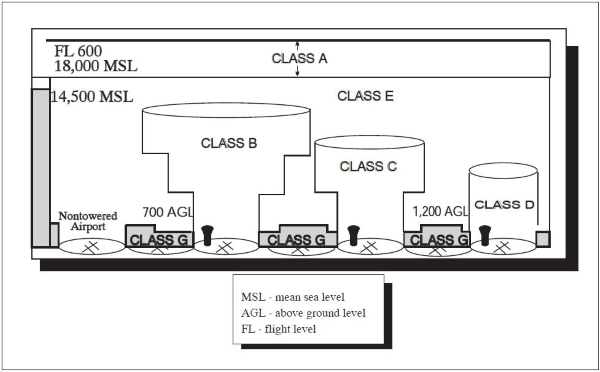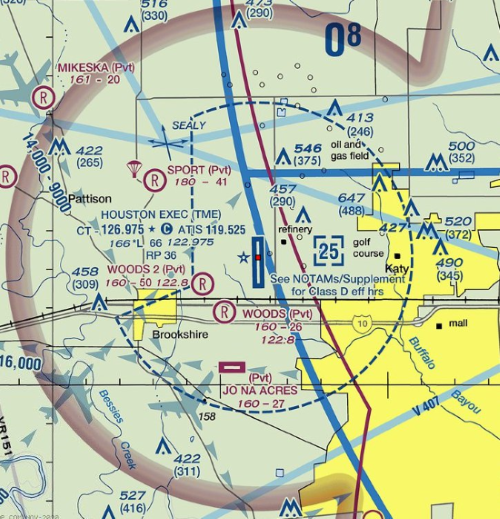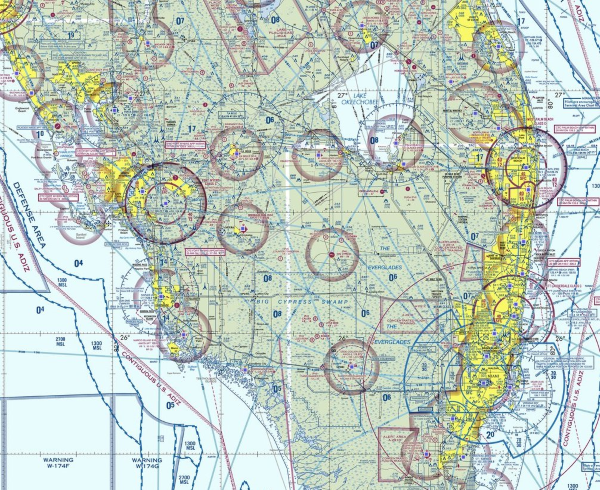Class G airspace can often times be confusing and misunderstood, especially for new pilots.
We are taught about Class A, B, C, and D airspace, and that E stands for everything else.
But what exactly is Class G airspace, where is it located, and what are the requirements to fly in it?
What are the weather and visibility requirements?
Is this airspace controlled or uncontrolled?
Keep reading to find out the answers to all of your questions!
Controlled vs Uncontrolled Airspace
Class B, C, and D airspace is the controlled airspace surrounding most towered airports, and some sort of communication with either a control tower or air traffic control is required to enter.
Class A is airspace from 18,000ft MSL up to 60,000ft MSL (FL600), and ATC clearance, along with an IFR flight plan, is required to enter class A.

If the airspace is neither Class A, B, C, or D, and is controlled, it is class E.
Any airspace that is not classified as Class A, B, C, D, or E, then it is considered Class G, and is uncontrolled.
There are, however, minimum VFR requirements to keep in mind before entering.
Related Article – Choosing A Flight School Near You
What is Class G Airspace?
Class G differs from other airspace in that it is the only one that isn’t controlled.
ATC has no authority or responsibility for controlling traffic in this type of airspace.
It starts from the surface and extends up to the floor of the overlying class E airspace, either up to 700ft AGL, 1,200ft AGL and occasionally 14,500ft MSL.
It is normally denoted by transparent magenta circles surrounding airports.
Class G Airspace Weather & Visibility Requirements
Although Class G is uncontrolled, it is also subject to the most weather restrictions based on where the airspace is located.
1,200ft or less above the surface (regardless of MSL altitude)
-
- Day: 1 statute mile visibility and clear of clouds
- Night: 3 statute miles visibility, 1,000ft above, 500ft below, 2,000ft horizontal cloud clearance
More than 1,200ft above the surface but less than 10,000ft MSL
-
- Day: 1 statute mile visibility, 1,000ft above, 500ft below, 2,000ft horizontal cloud clearance
- Night: 3 statute miles visibility, 1,000ft above, 500ft below, 2,000ft horizontal cloud clearance
More than 1,200ft above the surface and at or above 10,000ft MSL
-
- Day or Night: 5 statute mile visibility, 1,000ft above, 1,000ft below, 1 statute mile horizontal cloud clearance.
The reason behind these cloud clearance requirements is simple; you need to be able to see and avoid other traffic.
If you’re flying too close to clouds, or the visibility is very poor, than you won’t be able to maintain adequate separation from conflicting traffic.
Frequently Asked Questions
What’s the speed limit in Class G airspace?
Below 10,000ft MSL, the speed limit in this airspace is 250kts. This is to ensure adequate time for recognition and avoidance.
Above 10,000ft MSL, the requirement is to stay below Mach 1.
Is radio communication required in Class G airspace?
There is no requirement for communications within Class G airspace.
However, it is always a good idea to radio your intentions in the vicinity of an airport for traffic avoidance purposes.
Unless a Class G airport displays approved light signals or other visual markings to the contrary, each pilot will make traffic pattern turns to the left.
Although rare, it is possible for a Class G airport to have a control tower, in which case a pilot must establish communications with the tower beyond 4NM from the airport, up to and including 2,500ft AGL.

Can you fly IFR in Class G airspace?
Yes, it is possible to fly IFR in Class G airspace.
However, pilots are required to meet IFR altitude and flight level requirements.
14 CFR 91.177 requires pilots to remain at least 1,000ft above the highest obstacle within a horizontal distance of 4NM from the course indicated in the filed flight plan.
Because of this requirement, time spent in Class G under IFR conditions will be minimal, and is usually reserved for the departure phase of an IFR flight out of an airport based in this type of airspace.
Lastly, if you’re flying in Class G airspace on an IFR flight plan for anything length of time, you need to follow specific altitude restrictions.
They are as follows:
If your magnetic course (aka ground track) is from 0 – 179 degrees, then you need to be at an odd-thousands altitude.
This means 3,000, 5,000, 7,000, and so forth.
If your magnetic course is anywhere from 180 – 359 degrees, then you need to be at an even-thousands altitude.
This means 2,000, 4,000, 6,000, and so forth.
How high can Class G airspace go?
Generally, Class G airspace extends up to the floor of Class E airspace, up to 14,500ft MSL.
Most of this airspace is confined to small areas around uncontrolled airports, between 700ft AGL and 1,200ft AGL.
The remainder is in remote areas where ATC control is impractical.
Is there Class F airspace?
The reader may have noticed that there is no Class F airspace listed.
That is because, in the United States, there is no Class F airspace.
However, Canada uses Class F airspace, reserved for special uses.
There are different zones based on the activities, and pilots operating in Class F need permission to enter the airspace, but are encouraged to avoid it if possible.
Conclusion
Class G airspace can be somewhat confusing to new pilots.
In general, it is uncontrolled airspace outside of the ATC system, surrounding non-towered airports, and ending where Class E airspace begins, normally 700ft AGL to 1,200ft AGL.
The speed limit in Class G below 10,000ft MSL is 250kts, and it has varying visibility and cloud separation requirements, based on time of day and altitude.
Due to the proliferation of ADS-B and the resultant better situational awareness, much of the Class G in remote regions has been phased out for Class E airspace.
Pilots are always encouraged to keep up to date sectional charts to stay on top of the changes.
References
FAA Regulations – https://www.faa.gov/regulations_policies/faa_regulations/
Federal Air Regulations AIM – https://www.faa.gov/air_traffic/publications/atpubs/aim_html/index.html


